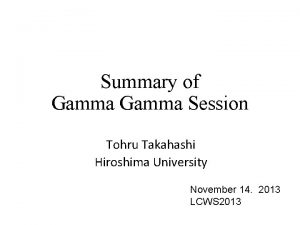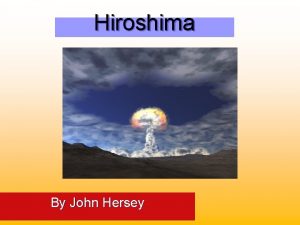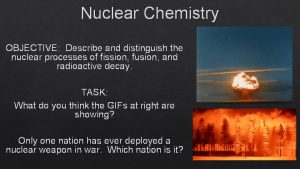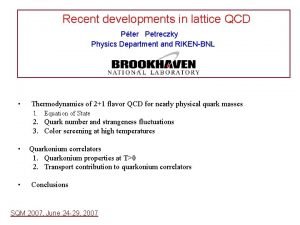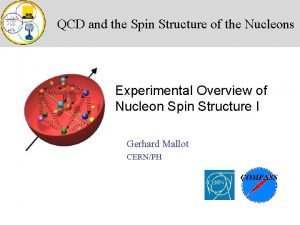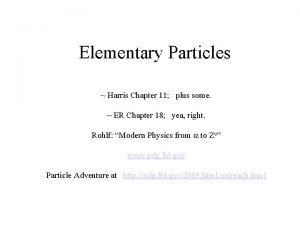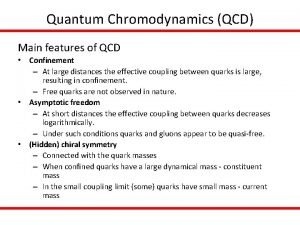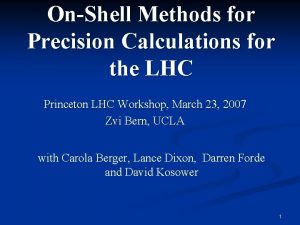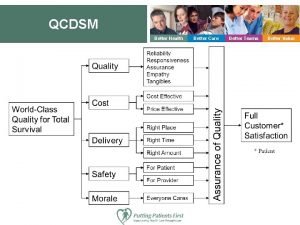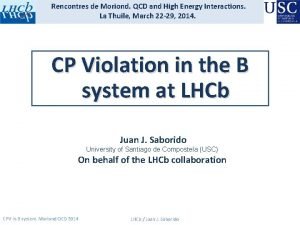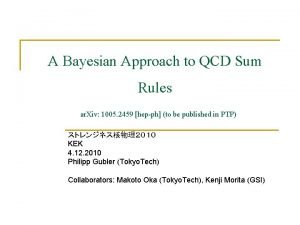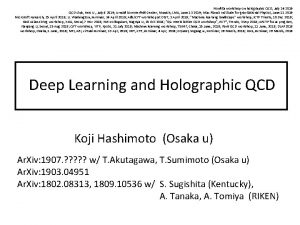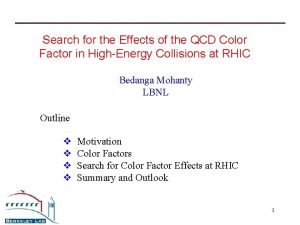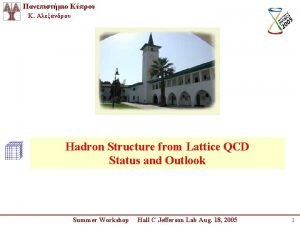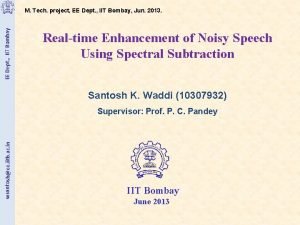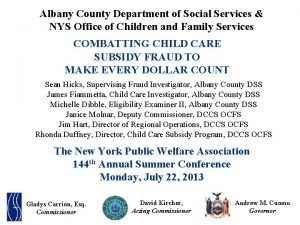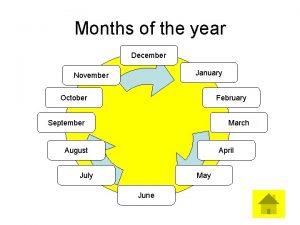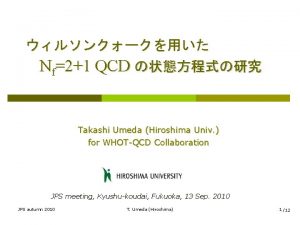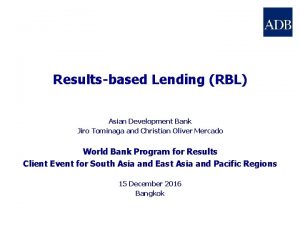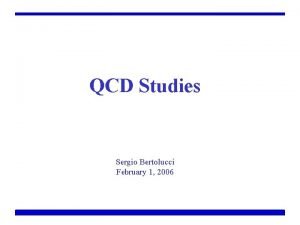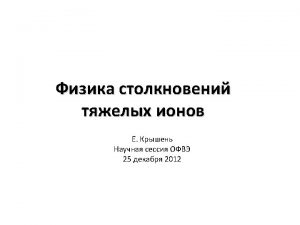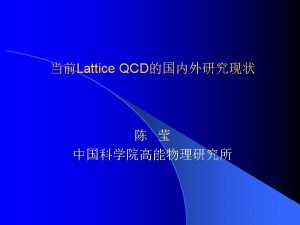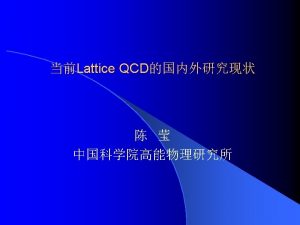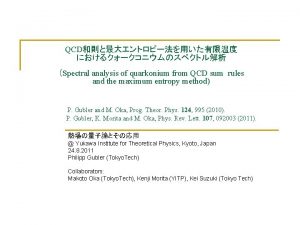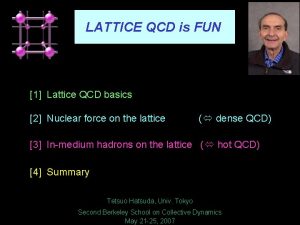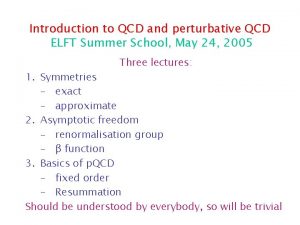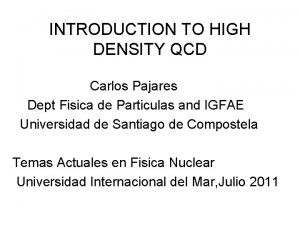QCD Jiro Kodaira Dept of QCD Hiroshima January










































![Choice of Scale Physically Natural One ← No Answer Check Stability with [pb] 43 Choice of Scale Physically Natural One ← No Answer Check Stability with [pb] 43](https://slidetodoc.com/presentation_image_h/dff956224b6b4d2ff0de94d15055b5e1/image-43.jpg)













- Slides: 56




アトラス日本 QCD 勉強会 (新年会?) Jiro Kodaira (Dept. of QCD*, Hiroshima) January 7 -8, 2005 at KEK 1. 2. 3. 4. Renormalization and Related Issues Basics of p. QCD Toward the Precision QCD Present Status and Future * Private


1. Renormalization and Related Issues Lagrangian and Two Suspicions Normalization of ? What are m 0 and g 0 ? Both were Fixed at Classical (Tree) Level 0 But m and g are parameters determined from “Experiments” 6

Renormalization One Must Define Coupling Constant g Corresponding to some (Arbitrary) Condition Very Important Lesson To Define Theory, a Scale μ is inevitable!! “Nature reads the books of free field theory” By Gell-Mann (’ 71) “God reads the books of interacting field theory” By J. K. (’ 05) 7

One Dimensional Toy Model Analysis Suppose for some Quantity F(p) Define “Renormalized Coupling Constant” such as NOTE: Renormalization Scheme = Choice of μ (Renormalization Scale) + Relation between g. R and F(μ) (Renormalization Prescription) 8

9

10

11

Renormalization Scheme and Ambiguity One Can Choose Any Renormalization Scheme Different Scheme ⇔ Different Definition of Z e. g. so Now, Tragedy and Destiny of Perturbation Theory 12

13

● EW-theory: Mass is Observable → Can be an Input Parameter On-Shell Scheme is “Natural” (Scheme Dependence is Small due to Small Coupling) ● QCD: Quark and Gluon are Confined → Can Not be Observed What does On-Shell Mean? (Scheme Dependence is Large due to Large Coupling) 14


2. Basics of p. QCD Basic Idea 1. Basic Ingredients ● Renormalization Group Equation Physical Quantity e. g. Cross Section CAN NOT Depend on μ (Renormalization Scale) ● Asymptotic Freedom When μ → Large , g (μ) → Small 16

2. General Strategy In QCD when μ→∞ , g (μ) → 0 What will Happen? If we Apply Perturbative Expansion from the Beginning to Quark and Gluon System In Real World, Quark and Gluon are Confined ↑ Relation to Real Observable will be Considered Later Consider “Observable” in Quark and Gluon World Q = Typical Momentum , p = Mom. of External Particle Neglect Mass Effects for Simplicity 17

18

19

20

Infrared Singularity (1 st Case) 21

22

23

24

25

26

27

Factorization (2 nd Case) Specified state in the Process e. g. DIS, Drell-Yan, 1 PI, …… → Mass Singularity Remains!! Singularity Should be Factorized to Obtain Well Defined Perturbative Part 1. Strategy and Scenario (for DIS) 28

What we Should (Want to) Show Mass Singularity is Factorized into Γ with C and q being Finite Where q 0 is “Bare” Distribution Function inside Hadron To Prove this, we take Normally 29

Processes for which Factorization Holds (Typical Examples) 30

2. DGLAP Equation “Observable” Should Not Depend on Factorization Scale ↓ DGLAP Equation We Call f PDF , ( C Hard Part ) f Contains Non-Perturbative Information so, Not Calculable in Perturbation Theory but its μF Dependence is Calculable if 31

PDF Depends on the SCALE!! QCD Improved Parton Model might be a Good Starting Point Partons (Quark and Gluon) Spread their Size due to QCD Interaction μF is the Analyzing Power of our Microscope so μF Shows μF-1 Scale Structure of Quark-Gluon Systems 32

3. Factorization Scheme Dependence There is Ambiguity in Definition of C and f ↑ Definition of Γ For Simplicity, Consider DIS and Take “Moments” and so 33

34

4. Importance of Factorization Theorem (Physical) (Arbitrary) Factorization → Well Defined Pert. and Non-Pert. Objects ● Universal Objects Fix by Some Experiments → Prediction for Other Exp. ● Simple Objects e. g. Light-Cone DAs Possibility to Go Ahead → Analytically, Lattice, etc. 35

5. Miscellany Difficult Question by Odaka-san “どんな場合に Factorize できるのか?” My Answer: I Do NOT Know, Process Dependent at Moment 36


3. Toward the Precision QCD To Reduce Theoretical Ambiguities (Error ≦ 10%) ● Scale (Scheme) Dependence X-Sections do not Depend on μ(R, F, …) BUT Truncation Does Induce Scale Dep. !! → LO (Nonsense) → NLO → NNLO → … ● Edge of Phase Space Perturbative Parts: Free From Singularity BUT In Edge Region of Phase Space Large Log Corrections → Resummation ● PDF , PFF Fitting (Non-Pert. Object) Data (HERA + TEVATRON + LEP) + Theory Used 38

PDF 1. Status until ‘ 04 (NLO = 1 -loop Hard part + 2 -loop DGLAP) To Determine PDF, Two Errors Enter Data + Theory (μR 2 = μF 2 = Q 2 : fixed ) 39

2. Status this Year NNLO = 2 -loop Hard Part + 3 -loop DGLAP Available !! Moch, Vermaseren and Vogt (’ 04) Error: NLO (10 -20%) to NNLO (a few – 10%) 3. MRST vs. CTEQ Differ in the Input Functional Form of PDF and Data Used Must Parametrize PDF at some Scale ≒ 1 ~ 3 Ge. V MRST: Conventional (Regge …. . ) CTEQ: Pragmatic (Best Fits …) 40

PFF (Heavy Quark Production) Total X-section, b-tagged Jets Theory and Data: Almost Consistent p. T Distribution of B Meson Cacciari and Nason (’ 02) Controversy ? But Fragmentation Functions FONLL by Cacciari, Greco and Nason (’ 98) 41

NLO/NNLO Example of Higgs Production (gg → H) at LHC (NNLO) ● LO (tree) Georgi, Glashow, Machacek and Nanopoulos ’ 78 ● NLO (1 -loop) Dawson ’ 91 Spira et al. ’ 95 ( Mt → ∞ ) ( Exact ) NLO Correction ~ 100 % !!!!! ● NNLO (2 -loop) Harlander ’ 00 ( Virtual ) Catani et al. ’ 01 Harlander and Kilgore ’ 01 ( Soft ) Harlander and Kilgore ’ 02 ( Numerical ) Anastasiou and Melnikov ’ 02 Ravindran et. al ’ 03 ( Exact ) NNLO Correction ~ Moderate 42
![Choice of Scale Physically Natural One No Answer Check Stability with pb 43 Choice of Scale Physically Natural One ← No Answer Check Stability with [pb] 43](https://slidetodoc.com/presentation_image_h/dff956224b6b4d2ff0de94d15055b5e1/image-43.jpg)
Choice of Scale Physically Natural One ← No Answer Check Stability with [pb] 43

Resummation Program : Finite in Distribution Sense !! → Does Not Mean Good Perturbation In Edge Region of Phase Space Two Scale Problem vs. One Scale Problem Ex. 1 Structure Function Small x ( s >> Q 2) , Large x ( s << Q 2) Ex. 2 Drell – Yan Type Process Threshold Logs Recoil or QT Logs Large αS ln 2 ( Ratio of Two Scales) Appear 44

Structure of PT with Two Different Scales Putting Rearrange Perturbative Series such that 45

Two Explicit Examples for D-Y Type Process → Resummation of Large Logs. to All Orders In Both Cases, with 46

47

48


4. Present Status and Future Key Points: ● PDF (NNLO) and PFF (FONLL ? ) ● NNLO Calculation (Present Status!!) 2 → 2, 2 → 3, … Two-loop Glover, Gehrmann, Remiddi, Bern, Dixon, Kosower, Chetyrkin, Tkachov, Giele, ……. ● NNLL Resummation (Present Status!!) ● Interplay between Perturbative ⇔ Non-Perturbative ● MC Simulation of Events Ref. e. g. W. J. Stirling, ICHEP 04 50

● Present Status of NNLO Calculation 51

Some Caveat for the List An Example for the Sum rule (e. g. Bj Sum Rule) Once upon a time, some people claim inclusion of higher order correction to C 1 improves the agreement of Th. with Exp. BUT Exp. (Left Hand Side) uses the NLO Formula!! 52

● Scale Ambiguity at NNLO (Jet Production) with C not known, so C = 0, ±B 2/A E. W. N. Glover 53

● NNLO (3 -loop) DGLAP (MVV) Small x behavior is Interesting !!? ? related to BFKL 54

● Higher Order Calculations at NNLO 2 → 2 Amplitude Master Integral: Almost Finished(? ) 2 →n Amplitude Very Difficult !!!!! Ask Dr. Yasui Maximum Helicity Violating (MHV) Amplitude Parke and Taylor (’ 86) Witten (’ 03) String Theory in Twistor Space? ? Cachazo, Svrcek and Witten (’ 04) ……. . 55

 Hiroshima
Hiroshima My momiji hiroshima university
My momiji hiroshima university Hiroshima
Hiroshima Tohru hiroshima
Tohru hiroshima Hiroshima
Hiroshima Hiroshima the liveliest city in japan
Hiroshima the liveliest city in japan Hiroshima shadow
Hiroshima shadow Human academy japanese language school review
Human academy japanese language school review Micron memory japan hiroshima
Micron memory japan hiroshima Qcd
Qcd Nucleon
Nucleon Qed qcd qfd
Qed qcd qfd Confinement qcd
Confinement qcd Qcd penrose
Qcd penrose Qcdsh
Qcdsh Rencontres de moriond
Rencontres de moriond Qcd sum rules
Qcd sum rules Qcd
Qcd Qcd lagrangian
Qcd lagrangian Color factor qcd
Color factor qcd Qcd
Qcd La dept of revenue
La dept of revenue Dept of education
Dept of education Gome dept
Gome dept Ohio employment first
Ohio employment first Department of agriculture consumer services
Department of agriculture consumer services Ee dept iitb
Ee dept iitb Bromocicloesano
Bromocicloesano Central islip fire department
Central islip fire department Hoe dept
Hoe dept Mn dept of education
Mn dept of education La geaux biz
La geaux biz Florida dept of agriculture and consumer services
Florida dept of agriculture and consumer services Gome dept
Gome dept Organizational structure of finance department
Organizational structure of finance department Dept ind onegov
Dept ind onegov Pt dept logistik
Pt dept logistik Rowan county dept of social services
Rowan county dept of social services Fire dept interview questions
Fire dept interview questions Affiliation poster
Affiliation poster Dept of finance and administration
Dept of finance and administration Rewley house continuing education library
Rewley house continuing education library Florida dept of agriculture and consumer services
Florida dept of agriculture and consumer services Gome dept
Gome dept Worcester inspectional services department
Worcester inspectional services department Albany county dss
Albany county dss Nys department of homeland security
Nys department of homeland security Maine department of agriculture conservation and forestry
Maine department of agriculture conservation and forestry Vaginal dept
Vaginal dept Dept. name of organization (of affiliation)
Dept. name of organization (of affiliation) Dept nmr spectroscopy
Dept nmr spectroscopy Nebraska dept of agriculture
Nebraska dept of agriculture Dept of education
Dept of education Dept a
Dept a Gome dept
Gome dept Dept. name of organization (of affiliation)
Dept. name of organization (of affiliation) Months of the year december
Months of the year december



